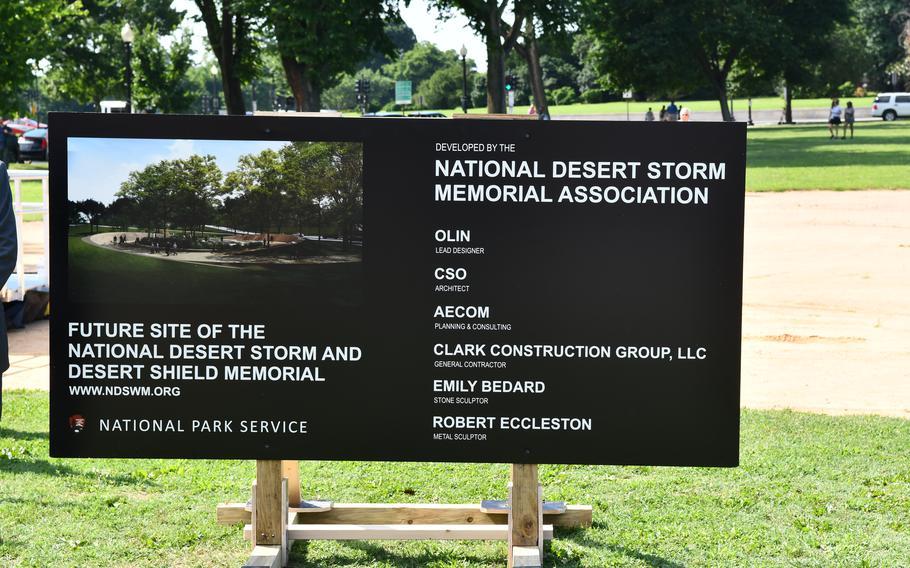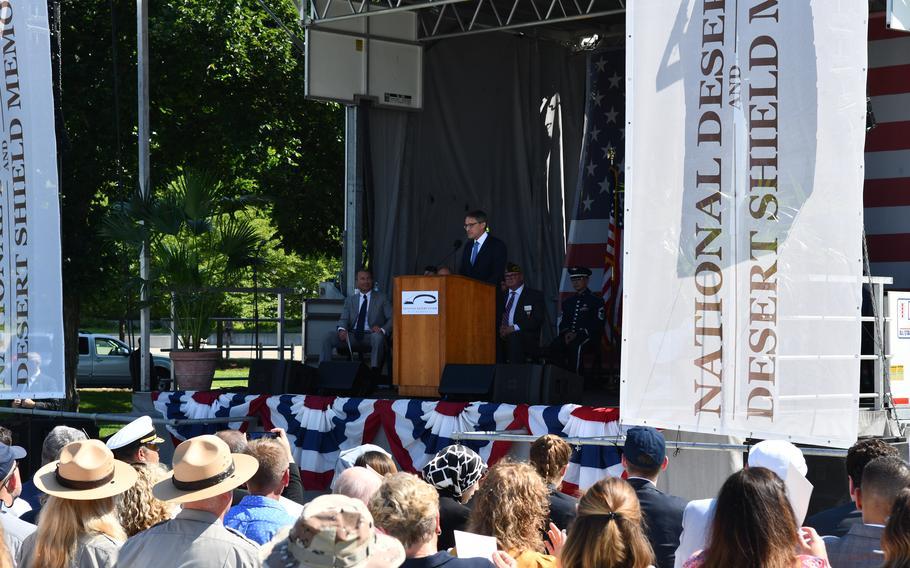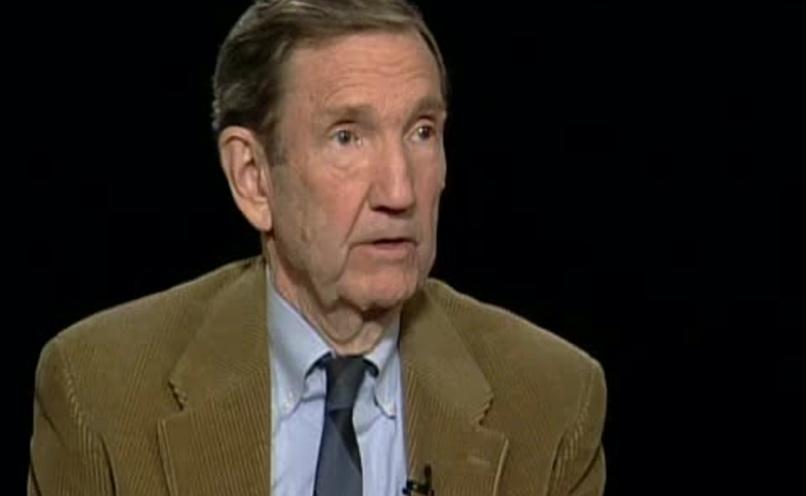
War over oil resulted in the deaths of an estimated 35,000 Iraqi soldiers, 299 American GIs, and 100,000-200,000 civilians, according to the British Imperial War Museum.
On July 14, the National War Memorial Society broke ground on a $40 million monument for Operation Desert Storm, the 1991 U.S. invasion of Iraq.
The monument will be built near the corner of Constitution Avenue and 23rd Street, NW, in Washington, D.C., across the street from the U.S. Institute for Peace and near the Vietnam War memorial.
Speaker after speaker at the 90-minute groundbreaking ceremony—which was attended by more than 100 Persian Gulf War veterans—heaped praise on the bravery of U.S. soldiers and extolled the nobility of the U.S. military mission in Desert Storm.

Scott C. Stump, the president and CEO of the National Desert Storm Memorial Association, who worked with Arkansas Senator John Boozman (R), sponsor of the congressional bill sanctioning the memorial, described the Gulf War in his opening remarks as the “triumph of good over evil.”

The long-time Kuwaiti ambassador to the U.S., Salem Abdullah Al-Jaber Al-Sabah, said that the war memorial would invoke the memory of those who made sacrifices to “give Kuwait freedom from the tyranny of Saddam Hussein.”

Echoing these claims, Derek Chollet, Counselor of the U.S. Department of State, recalled with nostalgia watching the U.S. air campaign over Iraq on CNN as a college student.
Chollet said that George H. W. Bush, James Baker, Dick Cheney, Colin Powell and other leaders of that era had orchestrated “one of the greatest triumphs of diplomacy” by forging alliances using the United Nations and marshaling an international coalition to “liberate Kuwait.”
According to Chollet, enlightened U.S. leadership at the time represented “the best of American foreign policy” and a “model for today.”

Retired Brigadier General Rhonda L. Cornum, a former army flight surgeon who is one of seven women to receive the Distinguished Flying Cross, compared the Persian Gulf War to World War II because “the moral stakes were clear” and “everyone believed that the U.S. had done the right thing.”
Cornum survived several broken bones and a gunshot wound during the war after her Black Hawk helicopter was shot down. She told the crowd that, while in captivity, she “never felt like she would be abandoned, holding absolute confidence in the army and civilian leadership. The war was a demonstration of all the good things that can happen when there’s an unambiguous and positive moral mission like liberating Kuwait from a brutal invasion.”

Chuck Horner, the head of the U.S. air campaign, followed Cornum by emphasizing the importance of having the Persian Gulf War memorial close to the Vietnam War memorial.
Horner—who admitted that the military exists for two reasons: to kill people and destroy things—said that future generations should study the way both wars were fought and see how the Persian Gulf War was fought the right way.

Dissenting Voice
One brave peace activist showed up to the ceremony, Joe Brown, a Washington, D.C., resident aged 71, with a sign that said: “No More War Memorials” and “Build Peace Memorials.”

Brown told CovertAction Magazine that he felt uncomfortable at the ceremony amidst all the military veterans, though some veterans asked for photos and supported his right to have his views, while most of the people driving by honked approvingly at his signs.
In Brown’s assessment, most of the money raised to build the memorial should instead be used to help homeless veterans and for programs that are designed to prevent more wars.
The conflict over Kuwait, he said, was “all about oil; the U.S. claimed to be saving Kuwait from aggression but has a history of being an aggressor like in the Korean and Vietnam Wars.”
Overall, it was a “bad war fought on foreign soil,” not for self-defense.
The U.S. was “interjecting itself into a local disagreement [between Iraq and Kuwait]” that had roots in the artificial creation of national borders during the period of British colonialism and “should have been settled at the United Nations.” Both countries were run by dictatorships.
According to Brown, the U.S. “is not and should not be the policeman of the world.”
U.S. War Crimes in the Persian Gulf
Brown’s perspective is reinforced by former U.S. Attorney General Ramsey Clark’s chilling book, The Fire This Time: U.S. War Crimes in the Gulf (1992), which recounts how the Persian Gulf War and subsequent sanctions that were imposed helped devastate Iraq.


Under Saddam Hussein—whom the U.S. had helped bring to power in the 1960s and supported throughout much of the 1980s because he was anti-communist and against Iran—Iraq developed advanced health-care and education systems along with a modern sanitation system and infrastructure.
When the U.S. and its allied partners began bombing, however, they caused “severe damage to homes, electrical plants, fuel storage facilities, civilian factories, hospitals, churches, civilian airports, vehicles, transportation facilities, food storage and testing laboratories, grain silos, animal vaccination centers, schools and communication towers,” according to Clark. “Most of the bridges we saw destroyed were bombed from both ends.”[1]

The sanctions in turn prevented needed equipment and materials from coming into the country that could rebuild it, and deprived Iraqis of vital food and medicines, resulting in the deaths of hundreds of thousands of Iraqi children, something that U.S. Secretary of State Madeleine Albright (1997-2001) said was “worth it” in the effort to contain Saddam Hussein.

On February 17, two laser-guided bombs struck the Al-Firdos air raid shelter in the Amiriyah district in West Baghdad, burning to death hundreds of civilians.
Eight days later, General Barry McCaffrey’s 24th U.S. Infantry Division staged a four-hour assault against retreating Iraqis near the Euphrates River, where U.S. A-10 Warthog planes fired high incendiary explosives at a rate of 4,200 rounds per minutes to the backdrop of Rossini’s William Tell overture.
The so-called “highway to death” became filled with “bodies, arms, legs and heads of…dead soldiers,” according to one eyewitness, some of whom were ripped apart from cluster bombs or “cooked to the point of carbonization.”[2]

Dr. Paul W. Roberts testified at the Montreal commission hearings on war crimes, November 15, 1991, that U.S. air attacks in the city of Basra were unlike anything that he had witnessed as a war correspondent in Vietnam: “After 20 minutes of this carpet bombing there would be a silence and you would hear a screaming of children and people, and then the wounded would be dragged out. I found myself with everyone else trying to treat injuries, but the state of the people generally was one of pure shock. They were walking around like zombies and I was too.”[3]
These comments underscore the horrendous human costs of the Persian Gulf War which is unlikely ever to be acknowledged in the new memorial—certainly not judging by the speeches that were given at the groundbreaking ceremony.

-
See Ramsey Clark, The Fire This Time: U.S War Crimes in the Gulf (New York: Thunder’s Mouth Press, 1992). ↑
-
Clark, The Fire This Time, 52-54; Robert Fisk, The Great War for Civiliaation: The Conquest of the Middle East (New York: Alfred A. Knopf, 2005), 640, 642; Michael Kelly, Martyrs’ Day: Chronicle of a Small War (New York: Vintage, 2001), 238, 240. ↑
-
Clark, The Fire This Time, 68. ↑
CovertAction Magazine is made possible by subscriptions, orders and donations from readers like you.
Blow the Whistle on U.S. Imperialism
Click the whistle and donate
When you donate to CovertAction Magazine, you are supporting investigative journalism. Your contributions go directly to supporting the development, production, editing, and dissemination of the Magazine.
CovertAction Magazine does not receive corporate or government sponsorship. Yet, we hold a steadfast commitment to providing compensation for writers, editorial and technical support. Your support helps facilitate this compensation as well as increase the caliber of this work.
Please make a donation by clicking on the donate logo above and enter the amount and your credit or debit card information.
CovertAction Institute, Inc. (CAI) is a 501(c)(3) non-profit organization and your gift is tax-deductible for federal income purposes. CAI’s tax-exempt ID number is 87-2461683.
We sincerely thank you for your support.
Disclaimer: The contents of this article are the sole responsibility of the author(s). CovertAction Institute, Inc. (CAI), including its Board of Directors (BD), Editorial Board (EB), Advisory Board (AB), staff, volunteers and its projects (including CovertAction Magazine) are not responsible for any inaccurate or incorrect statement in this article. This article also does not necessarily represent the views the BD, the EB, the AB, staff, volunteers, or any members of its projects.
Differing viewpoints: CAM publishes articles with differing viewpoints in an effort to nurture vibrant debate and thoughtful critical analysis. Feel free to comment on the articles in the comment section and/or send your letters to the Editors, which we will publish in the Letters column.
Copyrighted Material: This web site may contain copyrighted material the use of which has not always been specifically authorized by the copyright owner. As a not-for-profit charitable organization incorporated in the State of New York, we are making such material available in an effort to advance the understanding of humanity’s problems and hopefully to help find solutions for those problems. We believe this constitutes a ‘fair use’ of any such copyrighted material as provided for in section 107 of the US Copyright Law. You can read more about ‘fair use’ and US Copyright Law at the Legal Information Institute of Cornell Law School.
Republishing: CovertAction Magazine (CAM) grants permission to cross-post CAM articles on not-for-profit community internet sites as long as the source is acknowledged together with a hyperlink to the original CovertAction Magazine article. Also, kindly let us know at info@CovertActionMagazine.com. For publication of CAM articles in print or other forms including commercial internet sites, contact: info@CovertActionMagazine.com.
By using this site, you agree to these terms above.
About the Author

Jeremy Kuzmarov holds a Ph.D. in American history from Brandeis University and has taught at numerous colleges across the United States. He is regularly sought out as an expert on U.S. history and politics for radio and TV programs and co-hosts a radio show on New York Public Radio and on Progressive Radio News Network called “Uncontrolled Opposition.”
He is Managing Editor of CovertAction Magazine and is the author of six books on U.S. foreign policy, including Obama’s Unending Wars (Clarity Press, 2019), The Russians Are Coming, Again, with John Marciano (Monthly Review Press, 2018), Warmonger. How Clinton’s Malign Foreign Policy Launched the U.S. Trajectory From Bush II to Biden (Clarity Press, 2023); and with Dan Kovalik, Syria: Anatomy of Regime Change (Baraka Books, 2025).
Besides these books, Kuzmarov has published hundreds of articles and contributed to numerous edited volumes, including one in the prestigious Oxford History of Counterinsurgency .
He can be reached at jkuzmarov2@gmail.com and found on substack here.


How about a huge pile of plastic skulls for all the innocent men, women and children our brave men and women in uniform have murdered since the end of WW2? “Thank you for your service.”
[…] Yet Another War Memorial is Being Built — This Time to Commemorate 1991 Operation Desert Storm, by… […]
Perhaps if the Gulf War Syndromes, of both those who deployed and served on the home front, were addressed and investigated properly – especially concerning the use of experimental vaccines used upon military personnel – we would not be suffering the ills of a pseudo-pandemic today.